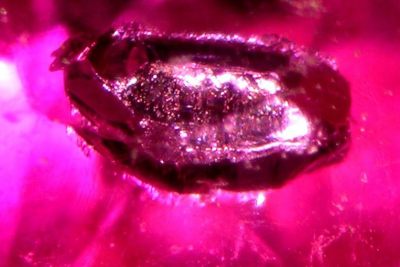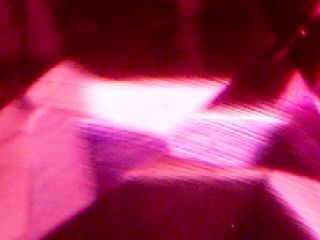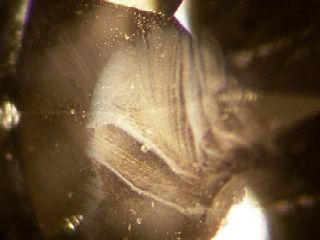The Corundum Minerals Sapphires and Rubies Corundum Minerals

A natural,uncut ruby in matrix. Most pictures on this site are my own work,
I had to buy this one, I don't own an uncut ruby.
Click here for larger image, opens in a new tab.

Above a faceted ruby with a large crystal inclusion.
The crystal fractured the stone, and the fracture filled with
micro-crystals, which are just visible as a fringe around the crystal. Unfortunately the faceting prevented us
from protographing the stone from the best angle, so the crystal looks distorted,
caused by different refraction through 2 facets.
Click here for
larger image.

Above a square-cut ruby. Note the fractures, one from top
left towards bottom right, the other crossing it. The stone is well cut,
and the fractures go straight down into it, minimising their impact on its
clarity. You can see two colours, a blue-red, and a more yellow
red (bottom left and right edge). This is a characteristic of ruby, caused by the way the crystal
refracts light.

Above the bands across this stone tell us it is lab-grown.
The pattern of growth causes these features. The facets are out of focus
because we are actually looking beyond them, inside the stone. While these
bands easily identify lab-grown stones, their absence is not proof that a stone
is natural.
Click here for larger image.
In brief
Except for diamonds, these are the hardest gems
They're easy to clean
Most gems are heat treated to improve clarity
Full info about Sapphires and Rubies
Corundum is aluminium oxide; apart from diamond, this is the
hardest mineral known to man. In industry corundum is used as an
abrasive. Emery is corundum with small amounts of haematite
or magnetite, that's why it's black.
Although very hard, like other gems the stones are somewhat
brittle, and can be cracked by a violent blow. However they
are less prone to this than diamonds, which is one reason
they are so useful in industry.
Lab grown stones are cheap. They are used
for bearings (e.g. mechanical watches). In the UK, lab-grown
stones must be declared as such. If not described as
lab-grown, assume the stones are natural. If buying
on holiday, care is needed. Buy
from shops with a good reputation.
Cleaning
They are easily cleaned with any proprietary cleaner or
detergent, but do check out
our advice on cleaning jewellery.
If the jewellery is valuable, it's best to get professional help.
Back to top

Above, This sapphire is early 20th Century. You can see signs of
wear, also an attractive colour band, common in natural sapphire. Click here for larger image
(opens in a new tab).

Above a zircon crystal embedded in the
sapphire has caused the stone to fracture. The fracture is as thin as an
oil film, hence the way it refracts the light. Although it looks so
spectacular, the light has to be at exactly the right angle; normally the
fracture is almost invisible. There are bands of rutile needle crystals
below the fracture halo.
Click here for larger image (opens in a new tab).

Above A silky veil of rutile crystals in a
very clear sapphire.
This picture was a challenge. Although the stone
looks dark in fact it's very pale
blue. The veil was almost invisible, and required careful
lighting. I tried moving the light to reduce the reflections and the veil
vanished!
Click here for larger image.
Treatments before purchase
Most stones are heat-treated to enhance their clarity.
Assume this has been done, unless you are advised
otherwise. The results are permanent.
Untreated stones are available, but seek expert advice if you
want to buy one, as they are much more expensive for the same
clarity, and treatments can be hard to identify.
Fractures are sometimes filled. Rubies are a major problem, fractures are often filled
with lead glass. This can make useless opaque stones look like good gems.
But the treatment is not permanent, and can be damaged by household chemicals, ultrasonic
cleaning and in other ways. The glass is much softer than
ruby, so, the stone will deteriorate with time.
At first the results look attractive, but they are not the same as a real clear ruby.
If a good clear gem is too expensive, consider lab-grown, it will last much longer.
Treated stones are hard for the buyer to identify, so only purchase from reputable
dealers. Jewellers can easily identify them.
Below
this stone was seriously fractured, almost opaque, and unsuitable for jewellery.
Lead-glass was forced into the fractures, producing a surprisingly clear stone.
How do we know it was treated? First you can see a lot of faint flaws.
But the real giveaway are the blue flashes, which come from the lead-glass.
Click here for
larger image.

Sapphire
While the blue form is the most common, other colours do
occur. The red form is Ruby, however the pink is
called Sapphire! The best stones are a bright transparent colour,
neither very pale or near black.
The ancients believed that simply looking upon this stone would
bring good luck. Visitors to Apollo's Oracle were expected to
wear a blue sapphire to ensure their questions were answered.
Sapphire is the birthstone for September.
Ruby
Most gems contain inclusions or fractures which reduce the
stone's clarity, good clean stones are highly prized, crystalline impurities can be beautiful.
The ancients believed high quality rubies protected the wearer
from danger - but the effect would be lost if these stones mixed
with lower quality rubies! They are July's birthstone.
Star Rubies
These lovely stones show a star which moves when the stone is moved.
Click here for more information.
Back to top








